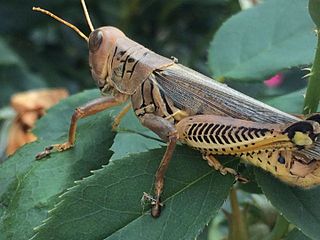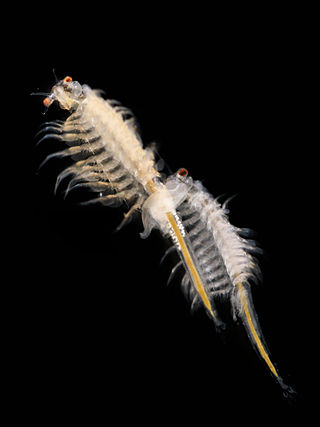Related Research Articles

Hemolymph, or haemolymph, is a fluid, analogous to the blood in vertebrates, that circulates in the interior of the arthropod (invertebrate) body, remaining in direct contact with the animal's tissues. It is composed of a fluid plasma in which hemolymph cells called hemocytes are suspended. In addition to hemocytes, the plasma also contains many chemicals. It is the major tissue type of the open circulatory system characteristic of arthropods. In addition, some non-arthropods such as mollusks possess a hemolymphatic circulatory system.

A rete mirabile is a complex of arteries and veins lying very close to each other, found in some vertebrates, mainly warm-blooded ones. The rete mirabile utilizes countercurrent blood flow within the net to act as a countercurrent exchanger. It exchanges heat, ions, or gases between vessel walls so that the two bloodstreams within the rete maintain a gradient with respect to temperature, or concentration of gases or solutes. This term was coined by Galen.

Artemia is a genus of aquatic crustaceans also known as brine shrimp. It is the only genus in the family Artemiidae. The first historical record of the existence of Artemia dates back to the first half of the 10th century AD from Lake Urmia, Iran, with an example called by an Iranian geographer an "aquatic dog", although the first unambiguous record is the report and drawings made by Schlösser in 1757 of animals from Lymington, England. Artemia populations are found worldwide, typically in inland saltwater lakes, but occasionally in oceans. Artemia are able to avoid cohabiting with most types of predators, such as fish, by their ability to live in waters of very high salinity.

Trehalose is a sugar consisting of two molecules of glucose. It is also known as mycose or tremalose. Some bacteria, fungi, plants and invertebrate animals synthesize it as a source of energy, and to survive freezing and lack of water.

Cryptobiosis or anabiosis is a metabolic state in extremophilic organisms in response to adverse environmental conditions such as desiccation, freezing, and oxygen deficiency. In the cryptobiotic state, all measurable metabolic processes stop, preventing reproduction, development, and repair. When environmental conditions return to being hospitable, the organism will return to its metabolic state of life as it was prior to the cryptobiosis.

Heterothermy or heterothermia is a physiological term for animals that vary between self-regulating their body temperature, and allowing the surrounding environment to affect it. In other words, they exhibit characteristics of both poikilothermy and homeothermy.
Peter William Hochachka, was a Canadian professor and zoologist at the University of British Columbia (UBC). He is known for his foundational work in creating the new field of adaptational biochemistry, connecting metabolic biochemistry with comparative physiology.

Campaniform sensilla are a class of mechanoreceptors found in insects, which respond to local stress and strain within the animal's cuticle. Campaniform sensilla function as proprioceptors that detect mechanical load as resistance to muscle contraction, similar to mammalian Golgi tendon organs. Sensory feedback from campaniform sensilla is integrated in the control of posture and locomotion.
Comparative physiology is a subdiscipline of physiology that studies and exploits the diversity of functional characteristics of various kinds of organisms. It is closely related to evolutionary physiology and environmental physiology. Many universities offer undergraduate courses that cover comparative aspects of animal physiology. According to Clifford Ladd Prosser, "Comparative Physiology is not so much a defined discipline as a viewpoint, a philosophy."

Journal of Experimental Biology is a peer-reviewed scientific journal in the field of comparative physiology and integrative biology. It is published by The Company of Biologists. The journal is partnered with Publons and has two-way integration with bioRxiv. Journal of Experimental Biology is now a hybrid journal and publishes 24 issues a year. Content over six months old is free to read.

Artemia salina is a species of brine shrimp – aquatic crustaceans that are more closely related to Triops and cladocerans than to true shrimp. It belongs to a lineage that does not appear to have changed much in 100 million years.
Desiccation tolerance refers to the ability of an organism to withstand or endure extreme dryness, or drought-like conditions. Plants and animals living in arid or periodically arid environments such as temporary streams or ponds may face the challenge of desiccation, therefore physiological or behavioral adaptations to withstand these periods are necessary to ensure survival. In particular, insects occupy a wide range of ecologically diverse niches and, so, exhibit a variety of strategies to avoid desiccation.

The work loop technique is used in muscle physiology to evaluate the mechanical work and power output of skeletal or cardiac muscle contractions via in vitro muscle testing of whole muscles, fiber bundles or single muscle fibers. This technique is primarily used for cyclical contractions such as cockroach walking., the rhythmic flapping of bird wings or the beating of heart ventricular muscle.

Psittacofulvin pigments, sometimes called psittacins, are responsible for the bright-red, orange, and yellow colours specific to parrots. In parrots, psittacofulvins are synthesized by a polyketide synthase enzyme that is expressed in growing feathers. They consist of linear polyenes terminated by an aldehyde group. There are five known psittacofulvin pigments - tetradecahexenal, hexadecaheptenal, octadecaoctenal and eicosanonenal, in addition to a fifth, currently-unidentified pigment found in the feathers of scarlet macaws. Colourful feathers with high levels of psittacofulvin resist feather-degrading Bacillus licheniformis better than white ones.
Fish are exposed to large oxygen fluctuations in their aquatic environment since the inherent properties of water can result in marked spatial and temporal differences in the concentration of oxygen. Fish respond to hypoxia with varied behavioral, physiological, and cellular responses to maintain homeostasis and organism function in an oxygen-depleted environment. The biggest challenge fish face when exposed to low oxygen conditions is maintaining metabolic energy balance, as 95% of the oxygen consumed by fish is used for ATP production releasing the chemical energy of nutrients through the mitochondrial electron transport chain. Therefore, hypoxia survival requires a coordinated response to secure more oxygen from the depleted environment and counteract the metabolic consequences of decreased ATP production at the mitochondria.
Charles Porter Ellington FRS was a British zoologist, emeritus Fellow Downing College, Cambridge, and professor emeritus at University of Cambridge.
The common raven, also known as the northern raven, is a large, all-black passerine bird. Found across the Northern Hemisphere, it is the most widely distributed of all corvids. Their Northern range encompasses Arctic and temperate regions of Eurasia and North America, and they reach as far South as Northern Africa and Central America. The common raven is an incredibly versatile passerine to account for this distribution, and their physiology varies with this versatility. This article discusses its physiology, including its homeostasis, respiration, circulatory system, and osmoregulation.
Hair-plates are a type of proprioceptor found in the folds of insect joints. They consist of a cluster of hairs, in which each hair is innervated by a single mechanosensory neuron. Functionally, hair-plates operate as "limit-detectors" by signaling the extreme ranges of motion of a joint.

Ronald Whittam is an English physiologist, who specialized in the field of cell physiology. He conducted important studies on the mechanism of active transport of ions across animal membranes and its relation to cellular metabolism. He is Professor Emeritus of Physiology at the University of Leicester. Whittam was appointed to the first Chair in Physiology at the University of Leicester.

The femoral chordotonal organ is a group of mechanosensory neurons found in an insect leg that detects the movements and the position of the femur/tibia joint. It is thought to function as a proprioceptor that is critical for precise control of leg position by sending the information regarding the femur/tibia joint to the motor circuits in the ventral nerve cord and the brain
References
- 1 2 James S. Clegg at Library of Congress
- ↑ Ancestry.com. U.S., Public Records Index, 1950-1993, Volume 2 [database on-line]. Lehi, UT, USA: Ancestry.com Operations, Inc., 2010. Voter Registration Lists, Public Record Filings, Historical Residential Records, and Other Household Database Listings.
- 1 2 3 James S. Clegg publications indexed by Google Scholar
- 1 2 Clegg, James S. (2001). "Cryptobiosis — a peculiar state of biological organization". Comparative Biochemistry and Physiology Part B: Biochemistry and Molecular Biology. 128 (4): 613–624. doi:10.1016/S1096-4959(01)00300-1. ISSN 1096-4959. PMID 11290443.

- ↑ James S. Clegg publications indexed by the Scopus bibliographic database. (subscription required)
- 1 2 3 4 5 6 7 Anon (2018). "James S. Clegg: Emeritus Professor". biology.ucdavis.edu. University of California, Davis. Archived from the original on 2018-03-02.
- 1 2 Clegg, James S. (1997). "Embryos of Artemia franciscana survive four years of continuous anoxia: The case for complete metabolic rate depression". Journal of Experimental Biology. 200 (3): 467–475. doi: 10.1242/jeb.200.3.467 . PMID 9318130.

- ↑ Clegg, James Standish (1961). The physiology of blood trehalose and its function during flight in the blowfly. jhu.edu (PhD thesis). Johns Hopkins University. OCLC 30555269.
- ↑ Clegg, James S.; Evans, David R. (1961). "The Physiology of Blood Trehalose and its Function During Flight in the Blowfly". The Journal of Experimental Biology . The Company of Biologists. 38 (4): 771–792. doi:10.1242/jeb.38.4.771.

- ↑ Clegg, James S.; Evans, David R. (1961). "Blood Trehalose and Flight Metabolism in the Blowfly". Science . 134 (3471): 54–55. Bibcode:1961Sci...134...54C. doi:10.1126/science.134.3471.54. ISSN 0036-8075. PMID 13694011. S2CID 35762256.

- 1 2 Clegg, James S. (1964). "The Control of Emergence and Metabolism by External Osmotic Pressure and the Role of Free Glycerol in Developing Cysts of Artemia salina". Journal of Experimental Biology. 41 (4): 879–892. doi:10.1242/jeb.41.4.879. PMID 14239915.

- 1 2 Clegg, James S. (1965). "The origin of trehalose and its significance during the formation of encysted dormant embryos of Artemia salina". Comparative Biochemistry and Physiology. 14 (1): 135–143. doi:10.1016/0010-406X(65)90014-9. ISSN 0010-406X. PMID 14288194.

- ↑ Clegg, James; Kell, Douglas; Knull, Harvey; Welch, G.Rickey; Wilson, John (2001). "Macromolecular interactions: tracing the roots". Trends in Biochemical Sciences. 26 (2): 91. doi:10.1016/S0968-0004(00)01739-4. ISSN 0968-0004. PMID 11327044.

- ↑ Clegg, James S. (1984). "Properties and metabolism of the aqueous cytoplasm and its boundaries". American Journal of Physiology. Regulatory, Integrative and Comparative Physiology. 246 (2): R133–R151. doi:10.1152/ajpregu.1984.246.2.R133. ISSN 0363-6119. PMID 6364846. S2CID 30351411.
